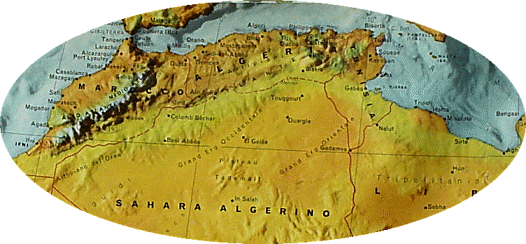

The faunistic population of North Africa, and especially of Maghreb
(Morocco, Algeria and Tunisia) is very interesting because it is a mix
of Mediterranean species with others typical of sub-saharian Africa and
Middle Orient, with a good number of endemis species and relict species.
This is particularly true among Insects, and it's easy to observe studying
Buprestidae of these countries. To understand Fauna and Flora of North
Africa, we must think the big Sahara desert, that's a very hard barrier
to the movements of animals and to propagation of plants, is a relatively
young structure. Few thousands years ago, most of this desert was steppe
of savana, and many species could live from tropical Africa to Mediterranean
region. In the Roman age, a large part of Lybia was cultivated (mostly
wheat), and it and Sicily were considered the "granaries of the Empire".
In the South of Tunisia, there were woods at the latitude of Gabes and
Tozeur (now there are just oasis in the middle of a subdesert), surrounding
a big lake (now there are just two big, and several little, salt lakes,
completely dried several months per years and full of salt water in rainy
seasons). In the Draa river (South Maroc, near the border with Algeria,
from the High Atlas mountains to the Atlantic Ocean) there were crocodiles
and many other big animals typical of tropical Africa. The last lion of
Maroc was killed less than 80 years ago. Now, most of the big animals are
extincted in North Africa, caused by human activities but also by a changing
climate.Among plants and insects there is something more. Some specie were
able to survive, adapting to the arid climate of this region.
Along the Mediterranean and Atlantic coasts we can find mostly a Mediterranean
Fauna. Related species live also in the mountains, where there are more
rains (and in many high mountains, also snow, usually from December to
March-April). From the South side of the Atlas Range, towards the Sahara
desert, there are mostly deserts species of insects and plants. Some of
them came from the North, other from the East deserts of Middle Orient,
others from savana and sahel, South of Sahara. Few others are probably
relictual elements of the ancient fauna of a less arid time.

Aurigena unicolor |
The genus Aurigena is particularly common in Middle Orient, with several species from East Mediterraneo to Iran, Iraq, Afghanistan, etc. Just a couple of species live in South Europe, and one of them reachs the North Africa, with 3 or 4 different varieties (or subspecies?). The typical form lives from the Atlantic coast to the North of Tunisia. |
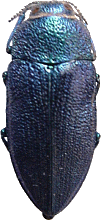
Aurigena unicolor leprieuri |

Anthaxia dimidiata |
In North Africa there are many species of Anthaxia. Most of them are closely related to South European or Middle Orient species, but there are also species coming from sahel, especially those living in trees and bushes of Acacia. The higher number of species live in the beautiful forests of Quercus, Abies and Cedrus in the mountains of Maroc and Algeria. |

Anthaxia bonvouloiri |
|
Anthaxia fulgidipennis |
Anthaxia pleuralis |
Anthaxia sedilloti |
Several species of Buprestis live in North Africa. Some of them are the same living in Pine-woods of Europe, or closely related species, but there are also species belonging to different groups. The most interesting is the group of Buprestis hilaris, douei and bilyi. They are very similar one to another, and their larvae live eating roots of Tamaryx (and perhaps of other bushes of arid places). |
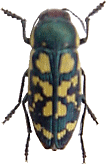
Buprestis douei |

Yamina sanguinea (male) |
Closely related to the genus Buprestis is Yamina sanguinaea. This very interesting monospecific genus is typical of North Africa (the same species lives also in the South of Spain, near Gibraltair). Larvae of this species live in Ephedra nebrodensis (and probably other species of the same genus of small bushes), and adults come out in August, in a very arid and hot season! Males and females are different in colouration, and it's surely uncommon among Buprestinae! |

Yamina sanguinea (female) |
|
There is a very strange similarity between females of Yamina sanguinea and the Australian species Stigmodera (Themognatha) martini. Notice that these are the most typical aposematic colours.They are also of the same dimensions |

Stigmodera martini (from Australia) |

Phaenops marmottani |
This species belongs to the oloarctic genus Phaenops (not all entomologists consider it a genus, but a subgenus of Melanophila). This species is quite different from other Palearctic species. It lives in the forests of Cedrus atlantica and Abies numidica of the Moyen Atlas. |
|
Paratassa sp. (Maroc) |
An endemic genus among Buprestinae of North Africa is Paratassa. Few years ago just one species was known (Paratassa coroebiformis), but now we know there are several different species, very similar one to another. |
Paratassa sp. (Tunisia) |
Another interesting genus is Cyphosoma. It is endemic of the Mediterranean Region. In West Mediterraneo there is only one species (Cyphosoma lawsoniae), living in Spain, Sardinia and North Africa. Other species live in Balcans and Middle East. This genus is closely related to another endemic genus of Mediterrane0 and Middle Orient: Capnodis. In North Africa there are only two species of this genus: Capnodis tenebricosa and Capnodis tenebrionis, the most common species, while the centre of evolution is in Middle Orient, and especially in Turkey. |

Cyphosoma lawsoniae |

Sphenoptera rauca |
The genus Sphenoptera is the biggest one among Buprestidae, except Agrilus. There are many hundreds of species living in Europe, Asia and Africa. They are particularly common in East mediterraneo, Middle Orient and Africa (especially in savana), but they are also common and with many interesting species in North Africa. They are mostly species belonging to Palearctic group, but there also some species of African subgenus. |

Sphenoptera impressifrons |

Sphenoptera pharao algirica |

Sphenoptera laticollis |
The giants among North-African Buprestidae are some Chrysochroinae in the genus Steraspis. There are 3 species living in Maghreb: Steraspis squamosa (living also in East Mediterraneo with a different subspecies), Steraspis speciosa (living also in Africa, South of Sahara), and Steraspis ceardi, endemic of South Maroc and near the Southern border Maroc-Algeria. These species live in the sub-desert, on trees of Acacia and Tamaryx. |
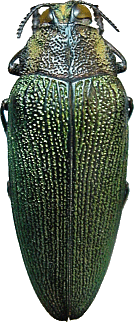
Steraspis speciosa |
Another genus with many species is Acmaeodera and the related Acmaeoderella. The first one lives in North and South America, Eurasia and Africa, but it's particularly coomon, with many species, in North America. Many other species live around the Mediterranean Sea. Most of North African species are the same or closely related to European, but we find species similar to others living in Middle Orient and several others endemic of North Africa. It's especially true in Maroc, where there is the maximum number of species. The same is for Acmaeoderella, an endemic genus of Mediterranean Region. They are particularly abundant in the region near the West High Atlas.
|
Acmaeodera affinis |
Acmaeodera rubromaculata |
Acmaeodera rubrom. ramosa |
|
Acmaeoderella discoidea |
Acmaeoderella henoni |
Acmaeoderella lanuginosa |
But the most exiting group of North African Buprestidae is probably
the genus Julodis. These species live, at the larval stage, free
in the soil, eating roots of many different plants, from herbs to trees.
Adults can be found on many kinds of plants, especially eating leaves of
bushes of subdeserts. In North Africa there are several species. Some belongs
to groups with other species in the Middle East (Julodis onopordi,
Julodis aequinoctialis, etc., others to saharian groups (Julodis caillaudi)
or with not clear relations with other Julodis. Click
here to see all North African species known at this time. Most of these species
are endemic of North Africa.
|
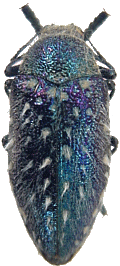
Julodis manipularis |